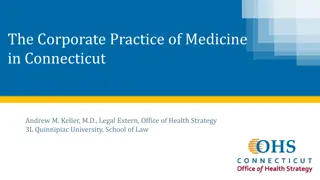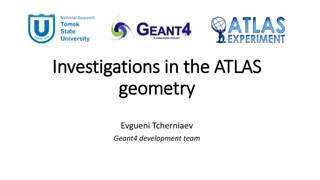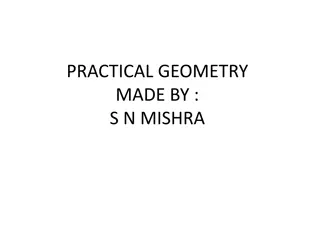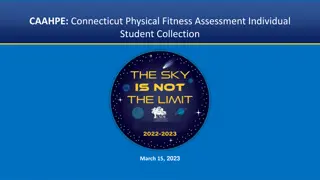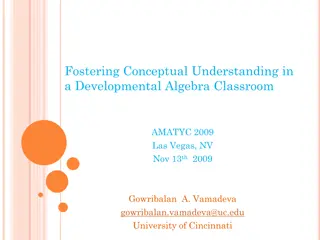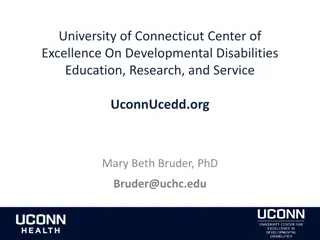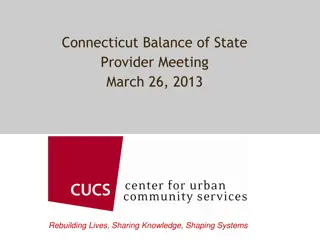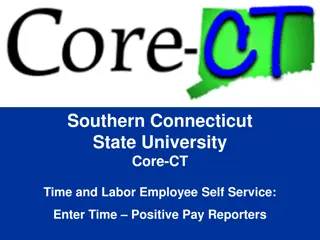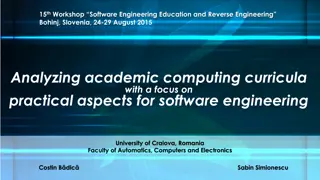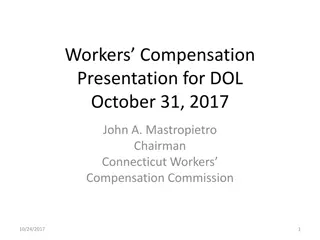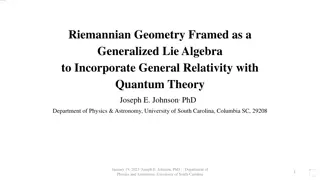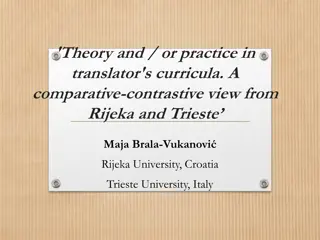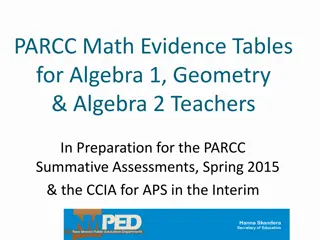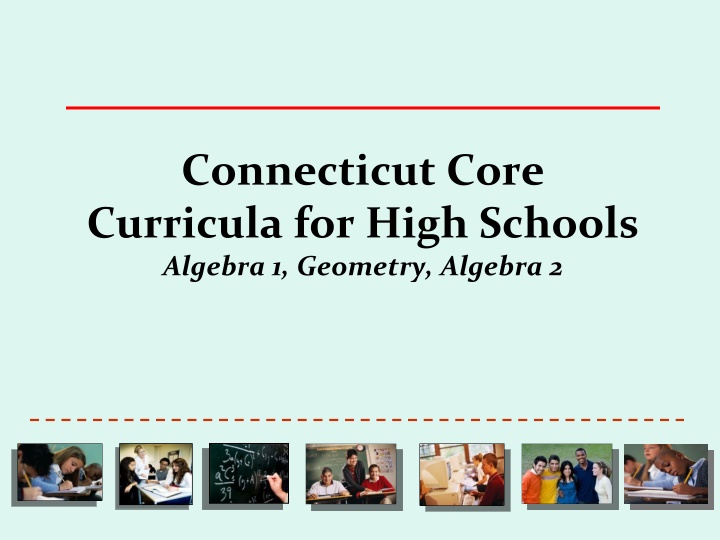
Connecticut Core High School Algebra Geometry Algebra 2 Curricula
The development process and importance of Connecticut's model curricula for Algebra I, Geometry, and Algebra II in high schools, aligned with Common Core State Standards. Discover the initiatives, requirements, and partnerships that shaped the creation of these curricula, emphasizing concepts and standards crucial for college and career readiness in STEM fields."
Uploaded on | 2 Views
Download Presentation

Please find below an Image/Link to download the presentation.
The content on the website is provided AS IS for your information and personal use only. It may not be sold, licensed, or shared on other websites without obtaining consent from the author. If you encounter any issues during the download, it is possible that the publisher has removed the file from their server.
You are allowed to download the files provided on this website for personal or commercial use, subject to the condition that they are used lawfully. All files are the property of their respective owners.
The content on the website is provided AS IS for your information and personal use only. It may not be sold, licensed, or shared on other websites without obtaining consent from the author.
E N D
Presentation Transcript
Connecticut Core Curricula for High Schools Algebra 1, Geometry, Algebra 2
Why did the state of Connecticut undertake to write a model curriculum for Algebra I? P.A.10-111 Secondary School Reform (passed in 2010, amended in 2011) CCSSM Common Core State Standards for Mathematics (adopted in 2010)
High School Requirements starting with class of 2021* 25 credits for graduation 8 in STEM areas with at least 4 in mathematics (including Algebra I, Geometry, Algebra II and/or Probability/Statistics) Model curricula to be developed for 8 courses including Algebra I Common final examinations for Algebra I, Geometry, Biology, English 2, American History *pushed back several times
First model curriculum to be developed was Algebra I (Geometry and Algebra II are now complete!)
Connecticut Algebra One Partners 2009 Associated Teachers of Mathematics in Connecticut (ATOMIC) Connecticut Academy for Education in Mathematics, Science & Technology, Inc. Connecticut Council of Leaders of Mathematics (CCLM) Mathematics Basic Skills Council of Connecticut (MBSCC) Mathematical Association of Two-Year Colleges of CT (MatyCONN) Project to Increase Mastery of Mathematics and Science (PIMMS)
SDE logo Algebra I Curriculum Components Guiding Principles-framed the work Big Ideas About Algebra-critical concepts Course-level Expectations/now aligned with CCSS Structure based on Units/Investigations/Activities Formative and Summative Assessments End-of-Course Test
Common Core State Standards Emphasis on Focus, Coherence, Conceptual Understanding HS standards for College and Career Readiness Most HS standards identified as core with additional standards for STEM Eighth grade curriculum will place major emphasis on algebra and geometry Connecticut Core Algebra I Curriculum is well aligned with these standards.
CCSS Standards for Mathematical Practice 1. Make sense of problems and persevere in solving them. 2. Reason abstractly and quantitatively. 3. Construct viable arguments and critique the reasoning of others. 4. Model with mathematics. 5. Use appropriate tools strategically. 6. Attend to precision. 7. Look for and make use of structure. 8. Look for and express regularity in repeated reasoning.
Pilot Study 2010-13 Year 1: Field test with 24 Teachers in 7 school districts. Year 2: An additional 28 Teachers in 10 districts joined. Curriculum was improved on the basis of feedback from Year 1 and Year 2. Year 3: Comparative study, conducted by Education Development Center (EDC)
Baseline and Year-End Math Assessment Scores by Group 20 15 12.0 11.9 10 11.3 9.9 5 0 Baseline CCSS Algebra I Curriculum Year-End Comparison
Conclusions from EDC Study Curriculum implementation and PD attendance varied among teachers. Teachers faced challenges with accessibility of curriculum for diverse students. Intervention teachers had significant positive changes in pedagogical preparedness and maintained their use of CCSS practices throughout the year. Students in intervention group were predicted to score 1.3 points (6.5%) higher than those in comparison group. There was a positive impact of the curriculum for both middle and high school students, although middle schoolers had higher baseline and year-end scores than high schoolers. Students taught by teachers who implemented more of the curriculum were predicted to have higher scores.
Development of Geometry and Algebra 2 Partnership between Connecticut State Department of Education and Central Connecticut State University Author team included faculty who helped develop and refine Algebra 1 curriculum; each responsible for one or more units Writing started in January 2015 Activity writers included high school teachers Version 1.0 was completed by June 30, 2015 and revised several times over the summer. Curricula was ready for adoption for 2015-16 school year with version 3.0 incorporating further changes and corrections.
Connecticut Core Curricula are accessible on line. CTCORESTANDARDS.org This is a public web site so there are no assessments or answer keys.
Algebra 1 Unit 1 Patterns Inv 1 Representing Patterns Inv 2 Patterns with Integers Inv 3 Arithmetic Sequences Inv 4 Geometric Sequences Inv 5 Patterns with Fractals
Unit 2 Equations and Inequalities Inv 1 Understanding Algebraic Equations Inv 2 One-Step and Two-Step Linear Equations Inv 3 Combining Like Terms to Solve Equations Inv 4 Solving Equations Using the Distributive Property Inv 5 Formulas and Literal Equations Inv 6 Linear Inequalities
Unit 3 Functions Inv 1 Relations and Functions Inv 2 What is a Function? Inv 3 Function Notation and Evaluating Functions Inv 4 Multiple Representations and Applications of Functions
Unit 4 Linear Functions Inv 1 What makes a Function Linear? Inv 2 Recognizing Linear Functions from Words, Tables and Graphs Inv 3 Calculating and Interpreting Slope Inv 4 Effects of Changing Parameters of an Equation in Slope-Intercept Form Inv 5 Forms of linear Equations: Slope Intercept and Standard Inv 6 The Point-Slope Form of Linear Equations
Unit 5 Scatter Plots and Trend Lines Inv 1 One Variable Data Inv 2 Introduction to Scatter plots and Trend Lines Inv 3 Technology and Linear Regression Inv 4 Exploration of Data Sets Inv 5 Exploring the Influence of Outliers on Trend Lines Inv 6 Piecewise Functions
Unit 6 Systems of Equations Inv 1 Solving Systems of Linear Equations Inv 2 Solving Systems of Linear Equations using Substitution Inv 3 Solving Systems of Linear Equations using Elimination
Unit 7 Introduction to Exponential Functions Inv 1 A New Function Family-World Population Growth Inv 2 Exponential Growth and Exponents Inv 3 Exploring Parameters of Exponential Functions Inv 4 Modeling Exponential Data Inv 5 Exponential Patterns and Percent Change Inv 6 Exponential Functions and Climate Change
Unit 8 Quadratic Functions Inv 1 Introduction Quadratic Functions: Parabolas Everywhere Inv 2 Quadratic Functions in Vertex Form Inv 3 Solving Quadratic Equations Using the Square Root Property Inv 4 Quadratic Functions in Factored Form Inv 5 Factoring Quadratic Trinomials Inv 6 Solving Quadratic Equations by Completing the Square and the Quadratic Formula
Connecticut Core Geometry: Key Features Follows structure of Algebra 1: Unit/Investigation/Activity Transformational approach as specified in Common Core Use of a variety of tools: compass/staightedge, coordinates, software (including Geogebra) In general, students will first discover properties using drawings, manipulatives, and/or software before writing a formal proof. Variable scaffolding on proofs to meet needs of diverse students.
Unit 1: Transformations and Coordinates* Investigations: 1. The Pythagorean Theorem and the Distance Formula 2. Vectors and Translations 3. Angles and Rotations 4. Reflections 5. Composition of Transformations 6. Isometries (Rigid motions) and Congruence 7. Symmetry * Titles and order of investigations as of March 2015
Unit 2: Congruence, Constructions and Proof Investigations: 1. Identifying Congruent Figures 2. Congruent Triangles: SAS and ASA 3. Isosceles Triangles 4. Congruent Triangles: SSS 5. Vertical Angles and Parallel Lines 6. The Construction Game 7. Proving That Constructions Work
Unit 3: Polygons Investigations: 1. Sums of Interior Angles 2. Inequalities in Triangles 3. Proving Lines Parallel 4. Regular Polygons 5. Properties of Quadrilaterals with Synthetic Proof 6. Properties of Quadrilaterals with Coordinate Proof 7. Introduction to Tessellations
Unit 4: Similarity and Trigonometry Investigations: 1. Properties of Dilations 2. Similarity 3. Proving that Triangles are Similar 4. Parallel Lines in Triangles 5. Similarity in Right Triangles 6. Special Right Triangles 7. Right Triangle Trigonometry
Unit 5: Circle and Other Conics Investigations: 1. Circles in the Coordinate Plane 2. Central Angles and Arcs 3. Radii and Chords 4. Tangents to Circles 5. Angle Bisectors 6. Inscribed Angles and Cyclic Quadrilaterals 7. Parabolas 8. (+) Ellipses and Hyperbolas
Unit 6: Three Dimensional Geometry Investigations: 1. Polygons and Polyhedra 2. Nets and Surface Area 3. Volume 4. Cross Sections and Solids of Revolution 5. Spheres 6. Geometry on the Sphere 7. Size and Shape in the Real World
Unit 7: Applications of Probability Investigations: 1. Sample Spaces 2. Theoretical and Experimental Probability 3. Independence of Events and the Multiplication Principle 4. Conditional Probability 5. Interpreting Two-Way Frequency Tables 6. Using Probability to Make Decisions 7. Geometric Probability
Unit 8: Additional Topics Topics for Teachers to present as special lessons or for students to explore as special projects. 1. 2. 3. 4. 5. 6. 7. 8. 9. ... more will be added. Border Patterns Further Investigation of Tessellations The Golden Ratio The History of Pi Pythagorean Triples The Fourth Dimension Non-Euclidean Geometry Fractals Topology Beyond the Common Core: Each state is expected to tailor 15% of its curriculum to its own needs. These topics constitute our 15%.
Differentiation and Scaffolding All three Connecticut Core Standards Curricula are intended for all students. Activity Overviews include suggestions for differentiating for learners needing more help and for enrichment Some of the Algebra 2 activities are written in 2 forms one with additional scaffolding Many complete activities and part of some are marked (+) for STEM-intending students Overviews in the resources provide information on activities which can be omitted or included as extras and for what reason
Functional Approach Looking at Relationships between Variables as the Basis for Algebra Balance between skill development and conceptual understanding, applications, and connections Emphasis on how the output changes in relation to a change in input When developing skills avoids unnecessarily complex algebraic manipulations Students discover patterns, properties, formulate definitions, theorems and laws based on observation of concrete examples and then they compare theirs to the formal ones
Functional Approach Looking at Relationships between Variables as the Basis for Algebra Emphasis on modeling Uses a compare and contrast approach between the function families studied and their various representations Utilizes data both from experiments in the classroom and researched Emphasis on recognizing patterns and the major characteristics of the function families
Alg 2 Unit 1 Functions and Inverse Functions Investigation 1: Systems of Linear Inequalities and Linear Programming Investigation 2: Relations and Functions Investigation 3: Types of Functions Investigation 4: Building New Functions From Old Investigation 5 (+): Composition of Functions Investigation 6: Inverse Functions Investigation 7: Root Functions
Unit 2 Quadratic Functions Investigation 1: Transforming Quadratic Functions Investigation 2: Methods for Solving Quadratic Equations Investigation 3: Complex Numbers Investigation 4: Fundamental Theorem of Algebra Investigation 5: Modeling with Quadratic Functions Investigation 6: Radical Equations
Unit 3 Polynomial Functions Investigation 1: Properties of Polynomial Functions Investigation 2: Polynomial Operations Investigation 3: Factoring Polynomials Investigation 4: Binomial Theorem Investigation 5: Polynomial Applications Investigation 6: Exponential vs Polynomial Growth
Unit 4 Rational and Power Functions Investigation 1: Indirect Variation Functions Investigation 2: Modeling with Power Functions Investigation 3: Graphs of Rational Functions Investigation 4: Operations on Rational Expressions Investigation 5: Operations on Rational Equations
Unit 5 Exponential and Logarithm Families Investigation 1: Logarithmic Functions Inverse of Exponentials Investigation 2: Natural Logarithm and Base e Investigation 3: Logarithmic Scales Investigation 4: Parameters of Exponential Functions Investigation 5: Curve Fitting with Exponential and Logarithmic Functions Investigation 6: Geometric Series Investigation 7: Financial Mathematics
Unit 6 Trigonometric Functions Investigation 1:The Unit Circle and Radian Measure Investigation 2: Unit Circle Definition of Trig Functions Investigation 3: Graphs of Trigonometric Functions Investigation 4: Transformations of Trig Functions Investigation 5: Models of Periodic Behavior
Unit 7 Inferential Statistics Investigation 1: Inference on Correlation and Regression Investigation 2: Collecting and Examining Data Investigation 3: Inference on Population Proportions Investigation 4: Inference on Population Means Investigation 5: Modeling Data Distributions Investigation 6: Inference on Categorical Data
Unit 8 Matrices Investigation 1: OPERATIONS WITH MATRICES Investigation 2: OPERATIONS WITH VECTORS Investigation 3: APPLICATIONS WITH VECTORS AND MATRICES Investigation 4: APPLICATIONS WITH 2 2 MATRICES Investigation 5: APPLICATIONS WITH n n MATRICES Investigation 6: APPLICATIONS WITH MARKOV CHAINS AND STOCHASTIC PROCESSES
Implementing This Curriculum Experience from Algebra 1: first year is the most difficult and pace will be slower. Collaboration with other teachers at your school will be extremely helpful. Along the way we will discuss specific suggestions to make this task easier. A pacing guide is available to assist with year 1, 2 and 3 of implementation as well as 45 minute periods and block
Give us your feedback! Please use the 3 x 5 cards throughout the workshop to write down questions, comments, and concerns, and leave them in the box in the back of this room. We will try to address all questions in the course of the workshop

